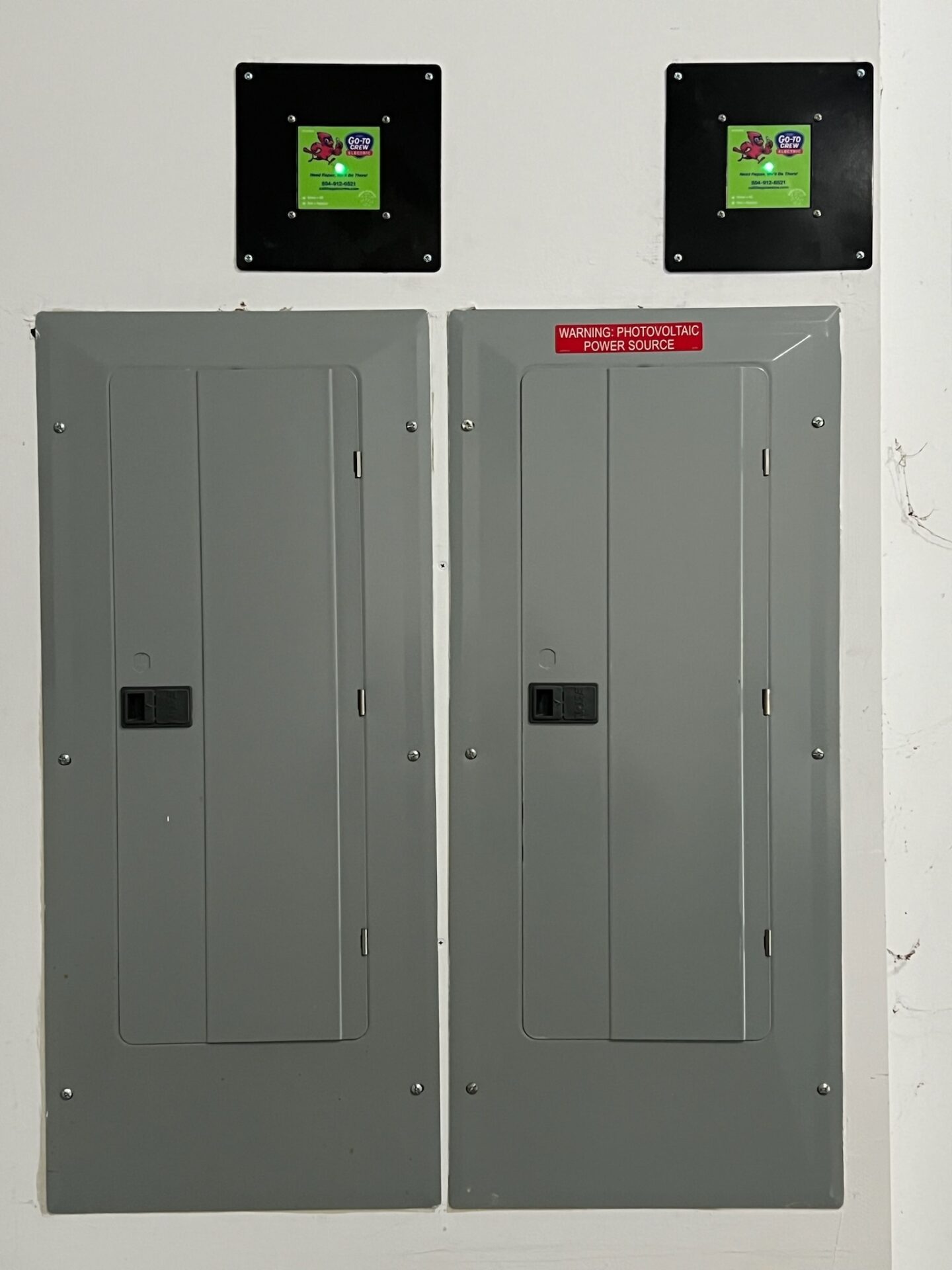Welcome to The Go-to Crew Electric’s exclusive buyer’s guide to electrical panel installations! Whether upgrading an outdated system or installing a new panel for your home, understanding the ins and outs of electrical panels is essential for ensuring a safe and reliable electrical infrastructure.
Understanding Electrical Panels
Before diving into the installation process, let’s start with the fundamentals. Electrical panels, often called breaker boxes or distribution boards, are the hubs that manage household energy. Power comes from the utility provider and is distributed to circuits throughout your house, protecting against overloads and short circuits.
Key Components
- Main Breaker: Controls utility electricity flow service into your home.
- Circuit Breakers: Individual switches that control power to specific circuits, such as lights, outlets, and appliances.
- Bus Bars: Metal strips that conduct electricity from the main breaker to the circuit breakers.
- Neutral Bus: Connects the neutral wires from the circuits to the central neutral wire.
- Ground Bus: Connects the ground wires from the circuits to the primary grounding wire.
Signs You Need a New Electrical Panel
Several signs indicate that it might be time to consider replacing your electrical panel:
- Frequent Circuit Breaker Trips: Frequent circuit breaker trips may signal electrical problems panel is overloaded or outdated. An overloaded panel may not be able to handle your home’s electrical demands, leading to tripped breakers as a safety mechanism.
- Flickering Lights: Flickering or dimming lights, especially when using appliances or turning on certain fixtures, can indicate voltage fluctuations caused by an inadequate electrical panel. This could indicate that your panel needs help to provide consistent power to your home.
- Buzzing or Crackling Sounds: Unusual buzzing, crackling, or humming sounds coming from your electrical panel could indicate loose or damaged wiring, which poses a fire risk. If you hear these sounds, it’s essential to have a professional electrician inspect your panel promptly.
- Warmth or Burning Smells: If you notice heat emanating from your electrical panel or detect a burning odor near it, it could be a sign of overheating due to loose connections or overloaded circuits. Overheating poses a significant fire hazard and requires immediate attention from a qualified electrician.
- Corrosion or Rust: Visible signs of corrosion, rust, or water damage on your electrical panel can compromise its integrity and safety. Moisture infiltration can lead to electrical shorts, arcing, and other serious issues, necessitating replacement of the panel to prevent hazards.
- Outdated Panel Design: If your electrical panel is equipped with fuses instead of circuit breakers or has other obsolete features, it may need to meet current safety standards or adequately support modern electrical demands. Upgrading to a newer panel with circuit breakers and advanced safety features can enhance the safety and efficiency of your electrical system.
- Home Renovations or Additions: If you’re planning significant renovations or additions to your home, assessing whether your electrical panel can handle the extra electrical load is a good idea. Upgrading to a larger panel or adding sub panels may be necessary to support the additional circuits and appliances.
If you notice any of these signs or have concerns about the safety and reliability of your electrical panel, it’s crucial to consult with a licensed electrician. They can assess your panel’s condition, recommend appropriate solutions, and ensure your electrical system meets current safety standards and codes.
Choosing the Right Electrical Panel
When selecting a new electrical panel for your home, several factors should be taken into consideration to ensure compatibility and functionality:
- Capacity: Choose a panel with sufficient amperage to meet your household’s electrical demands. Most home panels are 100-200 amps.
- Space: Consider the size and layout of your electrical panel location to ensure the new panel will fit comfortably and allow for future expansion.
- Safety Features: Look for panels with built-in GFCIs, AFCIs, and surge protection to enhance safety and protect against electrical hazards.
- Brand and Quality: Opt for reputable brands reliable and durable, covered by warranties and industry certifications.
- Compatibility: Ensure compatibility with your existing wiring and electrical system to avoid compatibility issues and costly modifications.
The Installation Process
Installing a new electrical panel is a complex task that is best left to trained professionals. Here’s an overview of the installation process:
- Assessment: A licensed electrician will assess your home’s electrical system and suggest panel size and type based on your needs.
- Preparation: The electrician will shut off power to the existing panel and carefully disconnect the old panel from the electrical service.
- Mounting: The new panel will be securely mounted in the designated location, ensuring proper clearances and accessibility for future maintenance.
- Wiring: The electrician will connect the main service wires to the new panel’s main breaker and route branch circuits to their respective circuit breakers.
- Testing: The electrician will test the panel after installation, check functionality and safety compliance.
Maintenance and Care
Proper maintenance and care of electrical panel installations are essential for ensuring your electrical system’s safety, reliability, and efficiency. Here are some basic tips:
- Regular Inspections: Schedule periodic electrical panel inspections by a qualified electrician to check for signs of wear, damage, or corrosion. This helps identify potential issues early and prevent electrical problems before they escalate.
- Keep It Clean: Ensure that the electrical panel and surrounding area are clean and free of dust, dirt, and debris. Use a soft, dry cloth to wipe down the panel and remove any buildup that could interfere with its operation.
- Check for Overheating: Periodically touch the electrical panel to check for signs of overheating, such as excessive warmth or burning odors. If you notice any abnormalities, contact a professional electrician immediately to investigate the issue.
- Monitor for Tripped Breakers: Watch for tripping circuit breakers in the electrical panel. If a breaker trips frequently or unexpectedly, it may indicate an underlying problem that needs attention.
- Avoid Overloading Circuits: Be mindful of the electrical load on each circuit and avoid overloading them with too many appliances or devices. Distribute the electrical load evenly across circuits to prevent overheating and potential fire hazards.
- Upgrade When Necessary: If your electrical panel is outdated or unable to meet the demands of your household or business, consider upgrading to a newer, more efficient model. Upgrading your electrical panel can improve safety, reliability, and energy efficiency.
- Follow Manufacturer Guidelines: Adhere to the manufacturer’s guidelines and recommendations for maintaining and caring for your specific electrical panel. These may include instructions for cleaning, servicing, and operating the panel safely.
- Stay Informed: Educate yourself about the warning signs of electrical problems and know when to seek professional help. Proactively addressing issues promptly can prevent costly repairs and potential safety hazards.
Following these maintenance and care tips, you can ensure that your electrical panel installation remains in good condition and functions reliably for years.
Congratulations! You’re now equipped with the knowledge and insights to make informed decisions about electrical panel installations for your home. At The Go-To Crew Electric, we’re dedicated to providing reliable and professional electrical services to ensure the safety and satisfaction of our customers.
If you’re ready to upgrade your electrical panel or have any questions, don’t hesitate to contact our team of experts. Let’s power up your home together!



